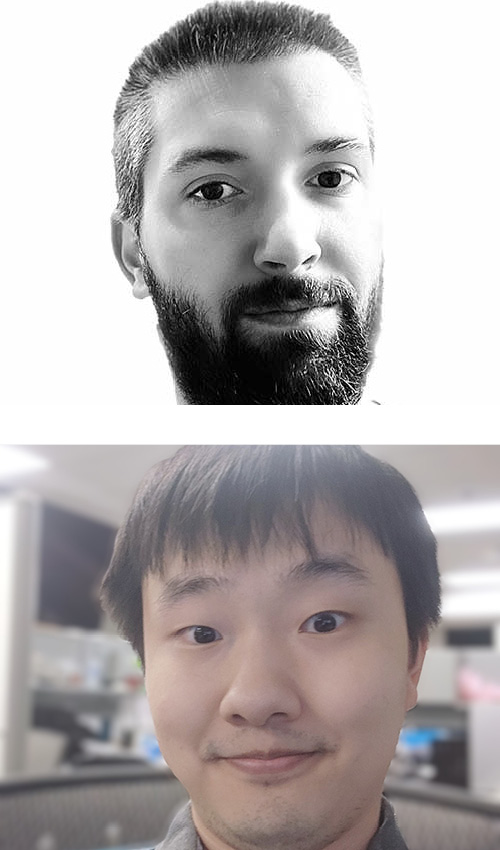Topics
Keynote presentations

Keynote address
Luke McNamara
Time: 9:10 a.m. - 10:00 a.m.
Audience: General audience
Format: Keynote address

Keynote address
Mark Daley
Time: 9:45 a.m. - 10:35 a.m.
Audience: General audience
Format: Keynote address
Breakout sessions
Tuesday, May 21

Time: 10:15 a.m. - 11:05 a.m.
Track: IT in Administration, projects, workshops, demonstrations or tutorials
Audience: General audience
In 2022 the ServiceHub identified that students were approaching us indicating that they were enrolled for the previous fall semester but didn't know they were enrolled. After a series of investigations we determined how this was happening. By working collaboratively we devised a plan to gather data points across a number of units that don't regularly work together to try to identify these students early so preventive action could be taken. This creative use of data and collaboration among various units led to a successful pilot project and positive outcomes for students. In this session we will outline how data can be used to come up with new ideas and the benefits of working and building relationships with units you may not regularly interact with.
Presenter: Gavin Taylor-Black, Registrar's Office (TMU)
Presenter biography
Gavin has worked at TMU for 16 years and has worked in admissions, student recruitment most recently the ServiceHub. During his time at the university he has been involved in using data in creative ways to inform decision making. As part of this current role as an advising and client support officer he has assisted with a variety of process developments and continually strives to improve service for students and staff.

Time: 10:15 a.m. - 11:05 a.m.
Track: Projects, workshops, demonstrations or tutorials
Audience: Technical staff, general audience
Research Data Management (RDM) refers to the storage, security, access and preservation of data produced from a given Scholarly, Research, and Creative (SRC) activity. Data management practices cover the entire lifecycle of the data, from planning the SRC activity to conducting it, and from backing up data as it is created and used to long term preservation of the data after the SRC activity has concluded.
Adopting best practices in RDM is an integral component of SRC excellence and can improve the discoverability and reproducibility of research outcomes. Additionally, data management plans (DMPs) and deposits in data repositories are increasingly required by research funders and publishers.
RDM at Toronto Metropolitan University (TMU) is supported across several units, including, but not limited to: Toronto Metropolitan University Libraries (Library), The Office of the Vice-President, Research and Innovation (OVPRI) and Computing and Communications Services (CCS). This session will highlight some of the RDM supports and services offered at TMU, including data management planning, data repositories, data storage and backup, and security considerations.
Presenters: Nora Mulvaney, Library (TMU), Casey Carvalho, Computing and Communications Services (TMU)
Presenter biographies
Casey Carvalho is the Director of Computing Infrastructure in Computing and Communications Services at Toronto Metropolitan University. He has been in this position for over 14 years. The Computing Infrastructure group is composed of the End-User Computing team, the Server & Storage Services team and the Database & ERP Administration team. Throughout his career, he has demonstrated fiscal responsibility, transparency and delivery of excellent value for IT services, while always introducing transformation and innovation.
Before joining Ryerson University, now TMU, he worked at Sheridan College for 9 years, leading the Server & Storage and the Network & Telecommunications teams. Prior to Sheridan College he worked at York University for over 14 years in various system administrator roles before becoming a Manager.
Nora Mulvaney has been the RDM Librarian at Toronto Metropolitan University since 2020. Her research interests include improving the discoverability of open data, interoperability in research infrastructure facilitated by persistent identifiers and data repositories. She regularly teaches workshops on research data management and data management planning.

Time: 10:15 a.m. - 11:05 a.m.
Track: Cybersecurity
Audience: Technical staff, general audience
A special presentation by the Government of Canada's Centre for Cyber Security discussing cybersecurity in the digital era, beyond borders.
Presenters: Glenne Berriault, Lead Information Security Advisor, Health & Academia Partnerships
Presenter biography
Glenne Berriault works as a Lead Information Security Advisor to a variety of critical infrastructure sectors for the Canadian Centre for Cyber Security. She brings with her many years of experience assisting with the development of IT infrastructure projects in campuses and hospitals across Canada and holds a Bachelors of Electrical and Biomedical Engineering and a Masters of Science in Electronic Health from McMaster University. Glenne’s research has centred on privacy, security and trust in machine learning in Canada.

Time: 11:15 a.m. - 12:05 p.m.
Track: IT in administration, Projects, workshops, demonstrations or tutorials
Audience: Technical staff, General audience
Take your Google Workspace proficiency to the next level. This session is designed for users who want to go beyond the fundamentals. We'll explore powerful features in Google Docs and Sheets that will enhance your collaboration and productivity. Discover hidden tools and shortcuts to make your daily work more efficient.
Presenter: Brian Alexander, Google
Presenter biography
When leading companies choose Google Cloud it's a huge win for spreading the power of cloud computing globally. As a Google Workspace subject matter expert for the public sector in Canada, Brian Alexander helps customers get the most out of Google’s collaboration and productivity tools.

Time: 11:15 a.m. - 12:05 p.m.
Track: Cybersecurity
Audience: Technical staff, general audience
As the cybersecurity landscape continues to evolve, the threats and risks facing an organization increase. 2024 is shaping up to be one of the most impactful years with a large number of severe cybersecurity incidents and data breaches, but why has there been an increase in successful attacks? During this session, an overview of the current threat landscape, treat actor trends, and why threat actors are targeting organizations. Finally, what can your organization do to lessen the potential for a cyber attack and increase your resilience. A perfect storm of threats, risks, and vulnerabilities have led to some of the most catastrophic cyber attacks in the last 18 months, but your organization doesn't need to be one of them.
Presenter: Steve Dyson, Unit 42 by Palo Alto Networks
Presenter biography
With a background in law enforcement and, more recently, in the healthcare sector, Steve Dyson is a principal consultant at Unit 42. He is highly skilled in cyber risk management, cloud security, threat mitigation, and intelligence gathering and analysis, having developed expertise in a range of cybersecurity incident response and threat hunting tools,
as well as in information security system design, management, and analysis. Steve joined the team in 2020 from Penn Medicine, one of the world's leading academic medical centers, where he was a security operations analyst leading incident response and focusing on investigations and threat intelligence. His work also included realigning and maturing of security operations processes, developing an incident response plan, and creating a medical device security program, in addition to overall risk and vulnerability management.
Previously, he was a cybersecurity operations senior consultant at Security Risk Advisors, where he managed client teams developing business process and incident response guidelines, adapting existing and current frameworks to GDPR and new SEC standards. His earlier work there included incident response, threat research, and open-source intelligence gathering.
Before that, he served almost nine years as a parole agent with the Commonwealth of Pennsylvania, supervising a caseload varying from 80 to 150 offenders and preparing and conducting parole/probation violation hearings. Having completed the FBI’s cyber first responder course, he handled intelligence gathering and analysis, threat assessments, and cyber forensics.
Steve is currently enrolled at Seton Hall University Law School working towards a Masters in Legal Studies with a focus on Privacy and Cybersecurity with graduation date in June, 2024. He completed his master’s degree in information technology from Carnegie Mellon University in 2021. He also earned his bachelor’s degrees in criminal justice and in security and risk analysis from Penn State.
In 2017, he was selected to serve in the U.S. Department of Homeland Security Secretary's Honors Program Cyber Student Volunteer Initiative, from which he was tasked to the PA Criminal Intelligence Center, where he produced intelligence reports and briefings and also developed the Commonwealth’s cybersecurity procedure best practices for small businesses. Steve began his career serving for five years in the United States Marine Corps, where he held a secret security clearance as a Lance Corporal leading a team that set up and maintained fuel systems for the Marines.

Time: 1:00 p.m. - 1:50 p.m.
Track: Projects, workshops, demonstrations or tutorials
Audience: Technical staff, general audience
Sa11y, the accessibility quality assurance assistant, originated in 2019 as an experimental tool within TMU's content management system, Adobe Experience Manager. Following its success, it underwent a redesign and was launched as open-source software in May 2020, coinciding with the onset of the pandemic. Since its debut, Sa11y has gained global adoption, with several hundred thousands monthly requests originating from the content delivery network (CDN) alone.
This session will explore:
- New Features: Explore the latest developments in Sa11y since the previous year's IT Conference, including support for additional languages, enhanced previews of hidden issues, the ability to export results, and an improved bookmarklet.
- Improved Developer Experience: Expanded options for creating custom checks or rulesets beyond accessibility, integration of the Playwright testing library, and additional props and methods.
- Integration at TMU: Learn about Sa11y's integration within various systems at TMU, including deployment at the Chang School and within our WordPress multi-network setup.
- Integrations beyond TMU: Explore Sa11y's integration into Joomla, one of the most widely used content management systems worldwide.
Presenter: Adam Chaboryk, Computing and Communications Services (TMU)
Presenter biography
Adam Chaboryk is TMU's IT Accessibility Specialist, where he enables the community with the resources and guidance to create a more inclusive digital environment for all learners, faculty, staff and the general public.

Time: 1:00 p.m. - 1:50 p.m.
Track: Cybersecurity
Audience: Technical staff, general audience
AI holds tremendous promise within post-secondary settings. Seeing the benefits, faculty, staff and students have been early adopters, leveraging AI and AI tools to support their work, research and studies. However, adoption often occurs without assessing the cyber risk to doing so. This interactive presentation explores the cyber risks associated with adopting AI technologies, discusses common attack vectors and provides important guidance on protecting critical AI assets and mitigating critical cyber risks.
Presenters: Randy Purse and Lester Chng, Rogers Cybersecure Catalyst (TMU)
Presenter biographies
Lester Chng is a cybersecurity and crisis management professional and he has extensive experience in establishing large-scale exercise programs in the North American financial services sector as well as the military. He was the financial institution’s lead representative in international and industry exercises, notably CISA’s Cyber Storm, NATO Locked Shields, Canadian Financial Sector Resiliency Group (CFRG), and Resiliency of the Wholesale Payment System (RWPS) exercises.
Lester is a former Naval Surface Warfare Officer of the Republic of Singapore Navy where he ran the Naval Wargaming & Simulation Centre. He was also the Squadron Head of Training and designed a turn-key training program to operationalize 8 brand-new warships. He has leveraged his experience in military wargaming to build cyber and crisis exercise programs. Lester holds the CISSP and PMP certifications and consults on Cyber and Crisis Exercises and personal branding for Cybersecurity professionals. He has recently authored The Essential Cybersecurity Exercise Playbook.
Dr. Randy Purse is a senior cybersecurity advisor for the Rogers Cybersecure Catalyst and a workforce development consultant for Quantum-Safe Canada. A veteran, Randy served in the Royal Canadian Navy for over 26 years, including a variety of security roles. He transferred to the Communication Security Establishment/Canadian Centre for Cyber Security, where he led development of IT security training and ultimately assumed the role of strategic advisor for cyber security training and education.
Following roles as the director of Cyber Security Standards and vice-president of future workforce development at TECHNATION, he assumed the role of senior cybersecurity advisor at the Rogers Cybersecure Catalyst. Engaged as a consultant for Quantum-Safe Canada, he was the primary researcher and author for the project document Organizational Migration to Quantum-Safe Cryptography: A Role-Based Framework, Learning Outcomes and Curriculum Model. Holding a PhD in education, Randy continues to research, write and consult on cybersecurity, workforce development and education and training issues.

Time: 2:00 p.m. - 2:50 p.m.
Track: IT in teaching and learning, IT in administration
Audience: General audience
All members of the Toronto Metropolitan University community have a shared responsibility to create and maintain learning, working and living environments that are free of discrimination and harassment. This is equally true for university activities that take place on campus and online. Human Rights Services leads TMU’s implementation of the Discrimination and Harassment Prevention Policy (DHPP), which operates to ensure equal rights and opportunities for all students, faculty and staff.
Since COVID, the workplace includes a “digital workplace” defined as the broad set of connected technologies that employees use on a daily basis to do their jobs. These span social, mobile, analytics, cloud technologies and the Internet of Things and include, for example, ‘intranet, communication tools, e-mail, HR systems, calendar and other enterprise processes or tools which assist in the general day-to-day functioning of the University. Just as the physical workplace is much more than a collection of desks, chairs, telephones, and other such artifacts, the digital workplace is more than its technological tools. It also includes a complex set of practices that involve elements of organizational culture, ways of working, leadership approaches, human interactions with co-workers and technology and more.
TMU’s human rights obligations under the DHPP and the broader EDI goals play a fundamental role in regulating TMU’s digital workplace. This presentation will go over the rights and responsibilities of faculty and staff under the DHPP in online environments and using information technology tools common in the hybrid workplace with a focus on how to maintain equity and protect human rights online.
Presenters: Tamara Sylvester, Erin Hallock and Ahmed Ahmed, Human Rights Services (TMU)
Presenter biographies
Tamara Sylvester is an experienced lawyer who has acted as both instructing and advocating counsel in various contentious public and civil law matters. Having advocated for the 2SLGBTQ+ community and for convicted persons sentenced to death, Tamara is dedicated to advancing human rights.
They also bring to the role their experience as a student-at-law in TMU’s Office of the General Counsel and Board Secretariat, as well as a specialization in meticulous reporting and presentation delivery.
Erin Hallock is an experienced human rights lawyer with a background in labour and employment law. She has also worked in national and international refugee law with Legal Aid Ontario and the United Nations High Commissioner for Refugees.
As a human rights trainer and educator, Erin is committed to expanding awareness of human rights issues throughout the TMU community and building partnerships with TMU stakeholders for the advancement of Human Rights at TMU
Ahmed Ahmed holds an undergraduate degree in Equity Studies from the University of Toronto and a Master's in Community Development and Adult Education from the Ontario Institute for Studies in Education (OISE/UofT). He has over 20 years of experience in program development and delivery, education and training, strategic planning and policy in the community development sector, federal public service and post-secondary education sectors. Ahmed joined TMU in 2017 where he has worked in Human Rights Services as the Strategic Advisor and Senior Resolution Officer for multiple years. His primary role in human rights is as the senior analyst, where he has played an instrumental role in various institutional-wide EDI and Human Rights initiatives such as the 2019 and 2024 Sexual Violence Policy review, writing various institutional and ministry reports as well as consulting on human rights and equity matters with leaders across the institution.

Time: 2:00 p.m. - 2:50 p.m.
Track: Cybersecurity
Audience: Technical staff, general audience
Since 2018 the higher education sector in Canada has made measurable progress in improving its cybersecurity posture. Ninety percent of its employees use multifactor authentication and so do many of its students. Tools like DNS firewalls have been widely adopted and there is a greater focus on cybersecurity awareness and training. So why were there six public breaches of universities in the last year? This presentation will use the most recent results from the CUCCIO cybersecurity benchmarking service to illustrate the challenges we face, discuss TMU’s current security posture, and make some recommendations on how we might all do better.
Presenter: Brian Lesser, Computing Communications Services (TMU)
Presenter biography
Brian Lesser is Toronto Metropolitan University's chief information officer (CIO). Brian helped develop the university’s first identity management system, establish an e-learning support team and was a founding member of the university's Digital Media Zone (DMZ) steering committee. The DMZ is TMUs startup incubator and accelerator. Brian is a board member of the Rogers Cybersecure Catalyst, manages the Canadian University Council of Chief Information Officers' (CUCCIO) cybersecurity benchmarking project and was a founding member of the Canadian Shared Security Operations Centre (CanSSOC) steering committee. Prior to joining TMU, Brian worked at the Xerox Research Centre of Canada and the National Archives of Canada.

Time: 3:00 p.m. - 3:50 p.m.
Track: Cybersecurity
Audience: Technical staff
In this scenario participants will go through five modules relating to cybersecurity. They will start by learning about recon and exploitation using Kali Linux acting like a penetration tester. Then moving on to wireshark to do an investigation of digital evidence obtained during a cyber event. In module 3 a vulnerability assessment is done against a network infrastructure. Moving on, participants will act like a hacker and attempt to exploit a web application using tools found on Kali Linux. Finishing with module 5 participants will learn more about post exploitation and Mitre Attack. Using Caldera to realize different attacker techniques and procedures.
Skills developed:
- Recon and port scanning
- Metasploit Framework basics
- Hash cracking tools
- Nessus and vulnerability assessment tools
- Wireshark investigations
- Web application tools
- Post exploitation tools
Prerequisite Technical Skills: Ideal for all skill levels, from Beginner to Advanced. In order to register, participants should be experienced IT professionals with a technical skill set, including: Basic understanding of computer networks, Basic knowledge of how to use Linux commands , Basic knowledge of how to use Windows and the command prompt
Delivery: 1.5 hours (additional 30 mins available if required by participants)
Virtual delivery
Up to 10 participants
Presenter: Ian McWillam, Rogers Cybersecure Catalyst (TMU)
Presenter biography
Ian McWilliam has been in the cybersecurity space for over 19 years with 10 of those years spent as an educator. He holds a bachelor of computer science and a master's of engineering in computer networks. He has a variety of certifications, including the certified information system security professional (CISSP) and offensive security certified professional (OSCP) designations. He continues to be passionate about information technology and has recently been focusing on cloud security and the cyber range.
Wednesday, May 22

Time: 9:00 a.m. - 9:50 a.m.
Track: IT in administration, IT Projects and Demonstrations
Lean is a proven methodology embraced by higher education providers worldwide to maximize value for students and staff while minimizing waste. The Financial Services team has embarked on a journey to apply Lean principles across their unit, aiming to enhance administrative processes, improve student services, and optimize resource allocation. Collaborating with KPMG, they are eager to share the impact of Lean on their daily operations and offer practical ideas for others across the University to adopt and benefit from.
Presenters: Channen Tan, KPMG; Joanne Mckee and Nadia Ferrari, Financial Services (TMU)
Presenter biographies
With over 25 years of experience in higher education, Joanne McKee leads TMU’s Financial Services department as the chief financial officer. She holds the Chartered Professional Accountant (CPA) and Chartered Accountant (CA) designations and is active within the higher education sector and has served in many volunteer leadership roles; she is currently a member of the Council of Ontario Finance Officers (COFO) and the Canadian Association of University Business Officers (CAUBO).
Joanne has been recognized for her support and contributions to higher education, receiving the COFO Distinguished Leadership Award in 2011 and 2019. She has also been recognized as the Brock University’ 2017 Goodman School of Business Distinguished Graduate and the 2019 CAUBO Ken Clements Award, which recognizes an administrator who has demonstrated outstanding leadership and has made an extraordinary contribution to the advancement of higher education administration.
Nadia Ferrari is an accomplished finance executive, transformational leader, and trusted advisor with more than 15 years’ experience serving in the higher education sector, in roles with increasing scope, spearheading modernization and optimization of financial operations to support growth and create value through implementation of processes and controls. Nadia partners with the highest levels of university administration (CFO, Vice-Presidents, and individual faculty Deans), serving as Senior Director to build strategy and capacity for exponential growth, leveraging influence to drive institution-wide adoption/compliance and financial flexibility.
Nadia is recognized for delivering responsive, courageous leadership and building engaged teams, while fostering a culture of inclusion, transparency, and collaboration. Nadia participates on various committees, leveraging strategy and vision to advise on and promote the University’s mission through sound fiscal accountability and good governance.
Channen Tan is KPMG’s National Lead Partner who leads the deployment of Lean transformational initiatives for clients all across Canada. Channen is passionate about driving continuous improvement, and has supported various higher education institutions to improve student experience, enhance operational performance and create a culture of continuous improvement from C-level to front-line staff by using proven design-thinking and Lean techniques.

Time: 9:00 a.m. - 9:50 a.m.
Track: Projects, workshops, demonstrations or tutorials
Audience: General audience
The creation of effective instructions can greatly assist the end user to confidently complete the required task(s) by breaking down the steps. Written instructions, complemented with video tutorials, are able to appeal to different learning styles and further engage the end user.
In this interactive "Using Video Tutorials to Enhance Technical Instructions" workshop, we will go through content creation and presentation techniques to equip the participants with the knowledge they need to create their own video tutorials for future projects. The workshop will be divided into the three sections outlined below.
- Section 1 of 3: Uses of Instructional Video Tutorials
- Section 2 of 3: Content Creation Considerations
- Section 3 of 3: Presentation Tips
Presenter: Dianne Nubla, School of Professional Communication (TMU)
Presenter biography
Dianne Nubla has taught courses for the Chang School and School of Professional Communication at Toronto Metropolitan University for over a decade. She also works with organizations to deliver business communication workshops and develop a variety of technical documents to streamline their workflow and educate internal/external audience of important company protocols and procedures.
Dianne has worked with banks, associations, financial organizations, agencies, and educational institutions to assist them with refining their employee’s professional communication skills and creating practical guides which transparently showcase the company’s internal processes.

Time: 9:00 a.m. - 9:50 a.m.
Track: Cybersecurity
Audience: Technical staff
Last year TMU's IT Security team presented on our automation hub. In that presentation we described how we integrate many security tools together, bringing in threat intelligence and triggering actions based on logs, data and logic we have developed. A huge piece of that framework is our SIEM (Security Information and Event Management). In this presentation we will take you through what a SIEM is, implementation, our struggles, wins, and what the future might have in store.
Presenters: Paul Webber and Yuchan Li, Computing Communications Services (TMU)
Presenter biographies
Paul Webber went to school for all things IT and began his career working for a network security managed service provider right out of school. With 17 years of experience in the IT security field, he currently manages the Toronto Metropolitan University six person IT Security operations team. Paul’s interests include Python, automation and digital forensics. He considers himself a hacker by old definitions and loves to break things down and figure out how they work.
Yuchan Li is a Senior IT Security Specialist from CCS IT Security team with a Master's degree in Computer Networks. With 5 years of specialized experience in administering IBM QRadar SIEM, Yuchan excels in building and maintaining use cases tailored to meet diverse security needs. Furthermore, as a proficient developer for security automation, Yuchan excels in seamlessly integrating SIEM, IDS, IPS, threat intelligence, and other security technologies into SOAR systems, ensuring comprehensive and proactive security measures.

Time: 10:00 a.m. - 10:50 a.m.
Track: IT in teaching and learning
Audience: General audience
Learning assessment, uncovering knowledge gaps that the learners need to bridge in order to achieve desired learning outcomes, plays a powerful role in effective learning. Automatic learning assessment, the utilization of computer technologies to evaluate students' work, has seen its increasingly rapid application due to advancement in information technologies. Commonly used automatic learning assessment technologies include online quizzes/exams, which, while providing immediate feedback, takes time to set up and are difficult to tailor to individual students' responses. Generative Artificial Intelligence (GenAI) tools utilize deep learning models such as gpt-4 to generate assessments (e.g., grade, comments) in the form of natural languages, and therefore holds the potential to revolutionize automatic assessment by assuming a central role in student learning assessment via immediate grading and personalized feedback.
In my presentation, I will demonstrate the application of the tool ProfGPT in automatic assessments of students' short answers and illustrate students' acceptance of the assessments. ProfGPT uses gpt-3.5 and is deployed using AWS for speed and security. The application exclusively relies on databases on business process management, thus avoiding common GenAI limitations such as misrepresentation. The tool has been tested on business process management and found to be able to produce coherent and relevant assessments. I will conduct an experiment to examine (1) how reliable and accurate is ProfGPT's automatic assessments and (2) the extent to which students accept ProfGPT's automatic assessments. The findings of the experiment will shed light on the benefits and lessons learned of using GenAI tools such as ProfGPT on learning assessment, and contribute to quality teaching and learning in the TMU community.
My presentation will cover the following content:
- Overview of GenAI tools for learning assessments
- Walkthrough of the tool ProfGPT
- Description of the experiment design
- Illustration of students' short answers and the ProfGPT's assessments
- Statistical analysis of reliability and accuracy of ProfGPT's assessments
- Statistical analysis of students' acceptance of ProfGPT's assessments
- Benefits and Lessons learned
Presenter: Linying Dong, Ted Rogers School of Management (TMU)
Presenter biography
Since 2004, Dr. Dong has been teaching at TMU. With strong commitment to quality teaching and to educating life-long learners, she has been actively using various technologies to engage student learning in and outside of classroom. Her outstanding efforts in learning and teaching has earned her recognition at the school and the university level.

Time: 10:00 a.m. - 10:50 a.m.
Track: Cybersecurity
Join us for an insightful session on how HPE Aruba enhances your security posture by enforcing the latest WPA3 standards. In this focused discussion, learn about the significant upgrades that WPA3 offers over previous protocols, including robust encryption techniques, increased protection against brute-force attacks, and advanced features like individualized data encryption. Aruba’s implementation of WPA3 not only tightens network security but also ensures compliance with the highest industry security standards. By integrating Aruba’s cutting-edge technologies, organizations can effectively shield their networks from a variety of threats, ensuring a safer and more secure wireless environment. Gain valuable insights into how Aruba can help you elevate your security measures to protect critical assets and data.
Presenter: Jason Fernyc, HPE Aruba
Presenter biography
Jason Fernyc is a Consulting Engineer with Aruba Canada, A Hewlett Packard Enterprise Company. He was employee #6 to join Aruba Canada, in 2007. He holds a Masters of Engineering (M.Eng.) in Internetworking From University of Alberta, holds a Professional Engineer (P.Eng.) designation with APEGA (Alberta’s version of PEO), and maintains a Networking Expert certification with CWNP (CWNE).
Jason has 27 years of experience in Networking and Telecommunications technologies, including 16 years architecting, designing, and implementing Aruba solutions for environments of all sizes. Jason’s design and consulting experience encompasses network designs across multi-vendor LAN, WLAN, WAN & Security technologies.

Time: 11:00 a.m. - 11:50 a.m.
Track: Cybersecurity
Audience: Technical staff, General audience
Join us for an electrifying session which shines a spotlight on women leaders in IT, sharing the challenges and victories that have shaped them into leaders today. Discover the critical role of cyber security, artificial intelligence, and technology as well as the importance of diversity in strengthening defenses and driving innovation. Gain insights and strategies from industry pioneers on fostering inclusivity and breaking down barriers. Whether you're a seasoned professional or just beginning your career in IT, this session provides actionable steps to create a more diverse and digitally resilient environment.
Presenters:
- Daniela Spagnolo, Chief Information Security Officer, Cyber Security Division, Ontario Public Service (moderator)
- Cheryl-Ann Rodriguez, Chief Information Officer, Central Agencies I&IT Cluster, Ontario Public Service (panelist)
- Kathryn Watson, Director of Privacy, Access, and Cyber Security Policy, Policy, Archives and Data, Ontario Public Service (panelist)
- Julia Le, Senior Manager Cyber Security Centre of Excellence Unit, Cyber Security Division, Ontario Public Service (panelist)
- Tiffany Landau, Senior Manager of Policy, Policy, Archives and Data, Ontario Public Service (panelist)
Presenter biographies
Daniela Spagnolo
Daniela brings over 15 years of executive, operational, financial, and relational leadership expertise, stemming from both the public and private sector. Since joining the OPS in 2016, she has held several leadership roles in the Infrastructure Technology Services (ITS) division, most recently as the Telecommunication Services director. Responsible for the strategic oversight of over 100 talented professionals, she works to help deliver a comprehensive cyber risk management program to Ontario.
Tiffany Landau
Tiffany Landau is the Senior Manager, Artificial Intelligence and Data Policy Unit in the Digital and Data Policy Branch of the Ontario Ministry of Public and Business Service Delivery. The Digital and Data Policy Branch develops timely and responsive digital and data policies, encompassing laws, frameworks, and policies for government and the people of Ontario to succeed in the digital world, including those related to artificial intelligence (AI). This includes Ontario’s Trustworthy Artificial Intelligence Framework (external link) which aims to set out risk-based rules for the transparent, responsible and accountable use of AI by the Ontario government.
Prior to her role with the Digital and Data Policy Branch, Tiffany spent the majority of her career as a community safety and justice policy expert with the Ontario Ministry of the Solicitor General. Tiffany holds a Bachelor of Arts in Criminology (with Distinction) and a Master of Arts in Public Policy and Administration from Toronto Metropolitan University.
Julia Le
Julia Le is the Senior Manager of the Cyber Security Centre of Excellence at the Government of Ontario, where she spearheads initiatives within the Cyber Security Division. Her role involves overseeing Ontario’s Cyber Security Centre of Excellence, offering strategic guidance and fostering collaboration to enhance the province’s cyber resilience and meet the evolving digital service needs of Ontarians.
Julia is a distinguished professional with a Bachelor of Law and Criminology from Wilfrid Laurier University and a Master of Public Policy from the University of Waterloo. Drawing on her extensive experience across all levels of government, she has held progressive positions in key areas including cyber security, innovation & economic development, and immigration.
Recognized for her outstanding leadership and contributions, Julia was honored with the Women in Leadership Award in 2023. She plays a pivotal role in establishing and nurturing partnerships for the Ontario government in the realm of cyber security, driving impactful collaborations and advancing the province’s cybersecurity agenda.
Cheryl-Ann Rodriguez
Cheryl-Ann is the Chief Information Officer (CIO) of the Central Agencies I+IT Cluster (CAC). In this role, she oversees the provision of digital business and enterprise applications, as well as professional services to users across the OPS; ensuring business partners have the tools, expert support and knowledge in place to optimize the value of I+IT investments to deliver a modern, tech-enabled government that ensures Ontarians have a simple, reliable, excellent, and consistent experience. In addition, she is co-lead for the implementation and industrialization of AI in the OPS.
Cheryl-Ann is an experienced professional with more than twenty-five (25) years of IT and leadership experience in solution delivery, people management, and relationship management. Prior to joining the public service Cheryl-Ann worked in numerous roles in the financial and energy private sector. Her focus on service excellence, building strong partnerships, taking strategic risks with a focus on priority outcomes, and building high performing teams has resulted in a variety of progressive roles since joining the Ontario Public Service (OPS) in 2010. In addition, as Executive Sponsor - her active leadership of the OPS Women in Tech (WIT) Program speaks to her commitment to diversity and inclusion in the IT work space, supporting and driving an inclusive mind-set.

Time: 11:00 a.m. - 11:50 a.m.
Track: IT in administration
Audience: Technical staff
DMARC policy is now being enforced more and more to prevent email spoofing and phishing. Recent changes of Google and Yahoo' policy, as well as TMU's plan on DMARC enforcement, will make email sent out from applications working differently. This session will go through some basic knowledge of DMARC, TMU's recommendations on how to set up email in applications etc.
Presenters: Clara Guo and Jonathan Engbrecht, Computing Communications Services (TMU)
Presenter biographies
Clara Guo, Manager, Application Infrastructure, CCS, TMU. Leading a team that develops and supports various applications including TMU Identity and Resource Management System (RMS), TMU Single Sign-on solution Central Authentication Service (CAS), Google Workspace at TMU, etc.
Jonathan Engbrecht has been working with email systems and security for his entire career, including two decades at TMU on both the Systems and Application Infrastructure teams. He wants to keep the bad email out of your Inbox, put the good email in it, and to avoid public speaking.

Time: 11:00 a.m. - 11:50 a.m.
Track: IT in teaching and learning, projects, workshops, demonstrations or tutorials
Audience: General audience
This presentation aims to guide the audience in crafting engaging and informative data narratives. It will cover the entire data journey, from data collection and exploration to cleaning, description, analysis, and ultimately, communicating the story behind the data. I will delve into the key elements of storytelling, including the data, the narrative, and visualization, illustrating how they synergize to create concise, informative, and captivating messages that resonate with your audience. The audience will learn the importance of a well-planned data story, which includes learning who your audience will be, what they should know and how to best deliver that information.
What’s a data story? It’s the art of conveying data not merely as numbers or charts, but as a narrative that that humans can easily comprehend. The goal of a data story is to provide context to help explain the importance of the data and help communicate any key messages you are trying to relay through your data story. Effective data storytellers excel at distilling their findings into a core set of information that conveys the message in a direct and concise manner.
Why tell a data story? Because stories are memorable and people easily relate to stories. Stories have historically been told for informing, updating, and conveying facts. In today's world, storytelling is more vital than ever, serving to persuade, sell ideas, convince, recommend, and entertain. When we weave a story around data, our aim is not merely comprehension but ensuring that the central ideas resonate and endure in the minds of our audience.
Speaker’s Background: I am currently an assistant professor of IT Management at the Ted Rogers School of Management. Previously, I held a position as a professor at the Carroll School of Management, Boston College. Currently, I teach an award-winning course on Data Visualization (ITM 752 Data Visualization). I developed this course in 2017 and have taught it in various formats at different universities, including MBA students (class size of 25), graduate students (class size of 30), and undergraduate students (class size of up to 80).
The primary aim of the course is to teach visual theory to help students create effective graphs and visual stories, while enhancing their critical thinking and communication skills. It provides students with the foundations and principles of data visualization to create meaningful displays of quantitative and qualitative data, facilitate managerial decision-making, and present insights clearly to engage their audience. Throughout the course, students learn visual critique and techniques for persuasion and effective storytelling through numerous examples of comparison and contrast. They also engage in hands-on projects with Tableau to explore various aspects of data visualization.
Core objectives of the presentation and envisioned activities during the session: In the first half of the session, I will share the fundamentals of creating effective data stories. The objectives are to help the audience develop an understanding of:
- Visual design theory and key techniques to create effective data stories.
- Effective uses of common chart and data types for presentation and storytelling.
I will also present practical visualization examples and review key visual analytics techniques using Tableau to help the audience gain practical understanding. Academics who attend the workshop can integrate these exercises into their teaching. In this half of the session, I will discuss the importance of telling truthful data stories (or developing the ability to identify unethical or manipulative data stories) and how these skills could be supported by teaching core concepts of visual theory and data visualization. I will also discuss potential skills that can be gained through this education, such as effective data exploration through visual thinking, effective communication, telling effective stories, detecting errors and bias, and so on.
The second half of the session will be dedicated to sharing my knowledge and experience in teaching Data Visualization. I will highlight the importance of teaching Data Visualization and integrating the concepts of visual design into information systems and data analytics curricula. During this part of the session, I will facilitate a discussion to explore ideas, techniques, and methodologies to advance our teaching and educational curricula and learn from the audience’s experiences. I will also promote incorporating these concepts into other classes at TRSM (e.g., marketing, HR management, accounting, and finance) to advance our teaching.
I believe this presentation is useful for both the IT and academic community. Students will develop awareness of the importance of the topic, and my colleagues and other IT community members will gain inspiration to integrate some of these ideas into their work or teaching.
Presenter: Burcu Bulgurcu, Ted Rogers School of Management (TMU)
Presenter biography
Professor Burcu Bulgurcu (Ph.D., M.Sc., Sauder School of Business, the University of British Columbia, M.Sc., B.Sc. Informatics Institute, Middle East Technical University) joined the Department of Information Technology Management of the Ted Rogers School of Management in 2019. Formerly, she was a professor of Information Systems in the Carroll School of Management, Boston College.
Dr. Bulgurcu’s research and teaching interests are cybersecurity, information privacy, social media and business analytics, and data visualization. Her research aims to provide guidance in the development of data protection and privacy preserving technologies, effective security and privacy policies, awareness, and training programs. She also explores the implications of social media use and privacy on creativity and innovation. The results of her research have been published in the Financial Times Top 50 journals and leading conferences, including a highly impactful paper published in MIS Quarterly with over 2700 citations, MIT Sloan Management Review, the Journal of MIS, Journal of the Association for Information Systems, ACM Transactions on Computer-Human Interaction, the International, Americas, and Hawaii International Conferences on IS. Bulgurcu’s research has been supported by the Social Sciences and Humanities Research Council of Canada and she has received numerous academic honours and awards.
She teaches a variety of classes on IT Management and Strategy, including a new elective class on Data Visualization, which she has designed and developed as part of the Data Science and Analytics programs in business schools.

Time: 1:00 p.m. - 1:50 p.m.
Track: Projects, workshops, demonstrations or tutorials
Audience: General audience
Demonstration of new and untapped features of Google Workspace.
Presenters: Albert Park and Anthony Fredericks, Computing Communications Services (TMU)
Presenter biographies
Albert Park is currently working in CCS, Toronto Metropolitan University, as Google Workspace Support Specialist. Dealing with day to day issues with all things Google and supporting in implementing new Google initiative to support departments and projects with Google Apps Script.
Graduated from McMaster University, worked in the private sector for 10 years before jumping into the public sector. In the past 18 years, has worked at University of Toronto (St. George Campus), and Toronto Metropolitan University (formerly Ryerson University) in IT implementation and support roles.
Cut teeth in Google, when it first launched Gmail in 2004 (but actually got my first account in 2006), not because it was the latest and the greatest, but for 1GB of storage space. Since then, had watched and experienced the evolution from Gmail and Google apps, to G Suite, to Google Workspace.
Anthony Fredericks is an Internet Specialist at Toronto Metropolitan University and an alumni of Business Technology Management. He started at the CCS Helpdesk; then moved over to the Faculty of Information Technology Management as a Program Assistant. He also worked in the Admissions department as a Technical Support Specialist. He currently supports Google Groups and the CCS website.

Time: 1:00 p.m. - 1:50 p.m.
Track: Cybersecurity
Audience: Technical staff, General audience
Now that the second set of National Cybersecurity Assessment (NCA) reports have been released and organizations are receiving their comparative BitSight Ratings and Grades for 2023/2024, this is a good time to talk about how these assessments help organizations improve their cybersecurity planning as well as focus on the most important things to do in the coming year.
The panel will discuss the most recent NCA and BitSight results, how best to put them to use and will look at TMU’s results as an example of the challenges and opportunities the assessments provide
Presenters: Curtis Blais, Alex Doradea-Cabrera, Wura Bamgbose
Presenter biographies
Wura Bamgbose recently took on the role of Chief Information Security Officer at Toronto Metropolitan University in 2023. She joined TMU’s Computing and Communications Services Department four years before taking on this position. Prior to joining TMU, she worked as a Technology Risk Consultant Leading various cybersecurity initiatives including developing cybersecurity roadmaps for companies and leading technology audits for large banks. Wura holds both a Masters and Bachelor’s Degree in Electrical and Electronics Engineering from the Georgia Institute of Technology (Georgia Tech). She also has a variety of certifications including the Certified Information System Security Professional (CISSP), Certified Information Systems Auditor(CISA), ISO 27001 Lead Implementer, amongst others.
Curtis Blais serves as Cybera’s shared Chief Information Security Officer (CISO) and the lead technical Architect on the National Cybersecurity Assessment (NCA) through CANARIE. He is multi-discipline certified with nearly 35 years of experience in the IT industry. Prior to joining the higher learning sector, Mr. Blais provided services to every level of government and held numerous positions in the private sector including Board of Director appointments for privately held corporations and a non-profit. In conjunction with his multiple certifications in networking, security and risk, Mr. Blais holds a master’s degree in leadership and organizational change from Royal Roads University, completed Harvard’s Cyber Risk Management program at the top of his cohort, and is currently completing a manuscript of a book detailing a streamlined approach to formalizing Information Security programs.
Alex Doradea-Cabrera is BCNET’s Cyber Security Specialist, as well as the technical lead on CANARIE’s National Cybersecurity Assessment (NCA). He has over 18 years of experience in the IT industry, of that, 10 years has been in the higher education sector. Prior to the NCA, Alex was instrumental in implementing the SIEM-As-A-Service initiative for BCNET and its members. He has expertise in Networking, Cybersecurity, service delivery and innovation. Alex is known for his strong collaborative partnerships with CANARIE and all levels of provincial NRENs. His “Why” consists of “implementing cybersecurity solutions that make a positive and lasting impact”.

Time: 2:00 p.m. - 2:50 p.m.
Track: IT in teaching and learning, Projects, workshops, demonstrations or tutorials
Audience: Technical staff, general audience
Just us for a virtual tour where TMU Libraries' Digital Media Experience (DME) staff guide attendees through three recently-refreshed services available to TMU staff, students and faculty:
- The Digital Media Experience lab (https://library.torontomu.ca/dmelab/), an accessible Makerspace and technology training facility open to all TMU students, Zone learners, staff, and faculty.
- The TMU Libraries Media Production Studio (https://library.torontomu.ca/dmelab/studio/), a flexible media recording space bookable to current TMU students and Zone learners.
- The Library's updated Media Equipment Lending Program (https://library.torontomu.ca/dmelab/equipment-borrowing) accessible to all Library users.
Staff will be available to speak to the technology resources as well as how these library resources can can be embedded into instructors' courses.
Presenter: James Loney, Libraries (TMU)
Presenter biography
As the TMU Libraries Digital Media Experience (”DME”) lab coordinator, James Loney manages programs and services offered through the DME lab. He is responsible for the DME’s technology infrastructure, digital media training initiatives, lab projects, and supervising lab staff. As a lifelong maker, James is passionate about connecting library patrons to first-rate technology and exceptional training support.

Time: 2:00 p.m. - 2:50 p.m.
Track: Cybersecurity
Audience: Technical staff, general audience
Known for our envelope-pushing approach to cybersecurity, the Rogers Cybersecure Catalyst is Canada’s only cybersecurity innovation centre. With programs focused on startup acceleration, career-changing education and scenario-based attack simulation, we foster the latest cutting-edge cyber technology with the goal of empowering individuals and organizations to seize the opportunities and tackle the growing challenges of cybersecurity. In our roundtable-style session, we will host three or four innovative cybertech companies whose time in the Catalyst Accelerator allowed them to develop and scale-up their startup companies in areas such as dark web monitoring, blockchain solutions, phishing simulations, behavioral biometrics, incident response, and more. After hearing from each company, we will transition into breakout rooms and allow audience members to participate in focused Q&A with our best and brightest cybersecurity innovators. This is an opportunity to learn about the unique gaps these new companies are trying to fill and your chance to provide insights for these companies
Presenter: Tiffany Kelly, Rogers Cybersecure Catalyst (TMU)
Presenter biography
Tiffany Kelly is the Innovation Program Lead for Catalyst’s Cyber Challenge and will work closely with Founders looking to design for or pivot to a new product market. As this is a new program, Tiffany is working closely with the Innovation Team to develop a recruitment strategy, program curriculum, and ensure that every Founder who comes into the Cyber Challenge receives an optimal experience tailored to meet the needs of their growing business. Previously, as Program Operations Coordinator for Catalyst Cybersecurity Training Programs, Tiffany worked closely with students to get them across the finish line of their studies. Drawing on her years of experience working with students — from children to adults — Tiffany ensured an optimal program experience by developing and delivering informational sessions, monitoring their progress reports, and being there when they needed advice and guidance. Prior to working at the Catalyst, she held project management, communication and coordination roles in both the non-profit and private sectors; most recently in TMU's Campus Tours Office. Tiffany is passionate about continuing education and takes to heart the words of C.S. Lewis: "You're never too old to set a new goal or to dream a new dream."

Time: 3:00 p.m. - 3:50 p.m.
Track: Cybersecurity
Audience: Technical staff
In this scenario, participants will experience both sides of a breach, holistically building their readiness for cyberattacks. They will start by acting like a hacker, breaking into multiple servers and/or domain controllers. They will then respond to the attack using commercial firewalls and tools. Participants will learn how to detect and identify specific characteristics of an attack.
Skills developed:
- SIEM monitoring with Splunk
- Firewall monitoring with Palo Alto
- Exploit Frameworks such as Metasploit
- Ransomware toolkits
Prerequisite Technical Skills: Ideal for all skill levels, from Beginner to Advanced. In order to register, participants should be experienced IT professionals with a technical skill set, including:
- Basic understanding of computer networks
- Basic knowledge of how to use Linux commands
- Basic knowledge of how to use Windows and the command prompt
Delivery:
1.5 hours (additional 30 mins available if required by participants)
Virtual delivery
Up to 10 participants
Presenter: Ian McWillam, Rogers Cybersecure Catalyst (TMU)
Presenter biography
Ian McWilliam has been in the cybersecurity space for over 19 years with 10 of those years spent as an educator. He holds a bachelor of computer science and a master's of engineering in computer networks. He has a variety of certifications, including the certified information system security professional (CISSP) and offensive security certified professional (OSCP) designations. He continues to be passionate about information technology and has recently been focusing on cloud security and the cyber range.
Thursday, May 23

Time: 11:00 a.m. - 11:50 a.m.
Track: IT in Administration
Audience: General audience
In less than two years, the quiet rumblings of Generative AI turned into a freight train of innovation and growing use, particularly on university campuses. In response, the Centre for Excellence in Learning and Teaching (CELT) created a GenAI Working Group to bring together partners from across campus to develop cross-institutional support. Since then, five strategic subgroups have been informed around Ethical Use, Technical Considerations, Student Support, Curriculum Development, and Teaching Development. This panel consists of members of the working group, old and new, who have experience supporting learning with technology. The panel will focus on intersections between technology and ethics when considering the future of learning in an age of AI.
Panelists: Sally Goldberg Powell, Centre for Excellence in Learning and Teaching (TMU); Hilary Julien, Computing and Communications Services (TMU); John Murray, The Chang School of Continuing Education (TMU); Lauren Di Mambro, Ted Rogers School of Management (TMU)
Moderator: Curtis Maloley, Centre for Excellence in Learning and Teaching (TMU)
Presenter biographies
Sally Goldberg Powell works on the design and development of multimedia learning materials and leads production for digital learning projects. She also teaches in the School of Journalism. For 17 years prior to her current position, Sally served as part of the technical support team at TMU's School of Journalism. Her focus was demonstrating and designing visual storytelling through video, graphics, motion graphics, and infographic design.
From 2018 to 2019, she designed several learning initiatives for the Creative School including the Faculty’s Level Up platform for students to expand their learning beyond the classroom, a digital art history course, and Accommodating Accommodation – a training course and resource for instructors.
Hilary Julien is an Instructional Technology Specialist in TMU's Digital Media Projects team, with experience in delivering digital learning solutions both online and in fabrication labs. Hilary holds a Master of Education and Master of Digital Media, and her professional background includes implementation of new technologies, facilitating faculty learning, and managing digital projects.
John Murray (he/him) is a Learning Experience Designer in the Digital Education Strategies (DES) unit at The Chang School. His experience more than a decade ago using technology for equitable collaboration and social good as a member of a global UN committee propelled him to obtain his MA in Educational Technology and enter the online learning space. In his work in the DES Learning Experience Design Lab since 2020, he emphasizes bringing authenticity, inclusion, and care to the design of online learning. He leads the Ethical Use subgroup within the CELT GenAI Working Group.
Curtis Maloley is the Director, Teaching Development and Digital Learning in the Centre for Excellence in Learning and Teaching. He has been teaching in the RTA School of Media, the Department of Sociology, and The Chang School since 2011. Curtis is the recipient of a President's Blue and Gold Award, an Alan Shepard Equity, Diversity, and Inclusion Award, and a Dean's Teaching Award. He sits as a non-Indigenous member of the Indigenous Education Council (IEC) and co-hosts Podagogies: A Learning and Teaching Podcast.

Time: 11:00 a.m. - 11:50 a.m.
Track: Projects, workshops, demonstrations or tutorials
Audience: General audience
On June 12, 2024 TMU Libraries will launch its new integrated library system, Omni.
A project of the Ontario Council of University Libraries’ Collaborative Futures initiative, Omni is powered by a partnership of team members and resources from 19 of Ontario’s university libraries. Omni users experience fast and easy access to a vast collection of diverse, high-quality, academic material, empowering them to confidently develop new insights in their areas of study, and succeed in their research goals.
This presentation will look at the technical implementation of the system as well as its anticipated impact on teaching and learning at TMU. We will discuss our management of implementing a new integrated library system for the first time in over 20 years and how this system differs from our current integrated library system, Sierra. We will also demonstrate how Omni will provide greater access to research materials from our own collection as well as those from the other 18 university libraries in Ontario.
Presenters: Kelly Dermody and Sally Wilson, Libraries (TMU)
Presenter biographies
Kelly Dermody is the Head of TMU Libraries’ Information Technology Services. She has been a Librarian at TMU for 19 years and her roles have included Library Accessibility Services and eLearning.
Sally Wilson is the Web Services Librarian at the University. In addition to managing the Library’s web presence she also collaborates on digital and OER projects and manages the Library’s Pressbooks publishing platform.

Time: 1:00 p.m. - 1:50 p.m.
Track: IT in teaching and learning
Audience: Technical staff, general audience
Digital Learning initiatives are supported by a wide array of TMU staff across the university. Day-to-day, we try to keep up-to-date with the current trends, understand what resources our faculty and contract lecturers have available to them and advise on the ways to use them effectively. In 2023, we started a Community of Practice to share experiences with our colleagues across the university.
We invite you to join us to discuss some of the topics that are top of mind for those of us who support digital learning initiatives across TMU.
Presenters: Stephanie Goetz, Computing Communications Services (TMU); Sally Goldberg Powell, Centre for Excellence in Learning and Teaching (TMU); Kelly Dermody, Library (TMU); Nada Savicevic, Centre for Excellence in Learning and Teaching (TMU)
Presenter biographies
Stephanie Goetz is the manager of Digital Media Projects in CCS and a member of the Centre for Excellence in Learning & Teaching. She has been implementing creative solutions with learning technology for over 20 years and is excited to be a part of its changing landscape.
Sally Goldberg Powell is the Instructional Technologist for the Digital Learning team at the Centre for Excellence in Learning and Teaching. In this role, she started the Supporting Digital Learning group in 2022 in order to build a network for technical and digital support staff across campus. Prior to joining CELT, Sally worked for over 20 years in technical support positions with RTA School of Media, Journalism, and the Creative School.
Kelly Dermody is the Head of TMU Libraries’ Information Technology Services. She has been a Librarian at TMU for 19 years and her roles have included Library Accessibility Services and eLearning.
Nada Savicevic is an Educational Developer with the Teaching Development & Digital Learning team at the Centre for Excellence in Learning and Teaching. Nada has been applying inclusive design, media, and emerging technologies to create equitable, accessible, and transformative digital learning experiences for over 20 years. Her research examines intersections of creative practice, technology, and education.

Time: 1:00 p.m. - 1:50 p.m.
Track: IT in administration
Audience: Technical staff, general audience
Since the early days of implementing and managing the wireless on campus, students, staff, faculty and administration alike have all experienced that eye rolling moment of frustration at some point. The wireless is slow, doesn't work or is having a bad day. Throughout the years the understanding, approach and response times to these issues have varied greatly. Since wireless is a very dynamic medium, constantly changing, along with the numerous different devices and their own personalities, keeping an eye on the quality and coverage is of utmost importance. The use of constant active monitoring, of not only signal strength, but various other mediums and metrics, allow us to proactively solve issues either before or as they are happening live, rather than reacting to issues long after they've begun or been reported. Come see how the Network team at TMU is leveraging Aruba's UXI sensor's, deployed all over campus, to keep an eye on the wifi.
Presenter: Josh Cave, Computing Communications Services (TMU)
Presenter biography
Josh Cave is a member of the TMU CCS Networking team. The Network team, which services the entire campus,encompasses both the wired and wireless sides of the network. Ranging from troubleshooting and dealing with clients in person, all the way through to building and planning full scale deployment architectures, Josh has been to every corner of campus and dealt with a wide array of challenges. Over the years these challenges have helped in creating custom solutions to issues presented in the unique University networking environment.

Time: 1:00 p.m. - 1:50 p.m.
Track: Projects, workshops, demonstrations or tutorials
Audience: General audience
The TMU School of Medicine Curriculum Development Team has developed the Cases and Persons Platform (CAPP), a Google Web application, to facilitate the development and tracking of medical cases for their curriculum. CAPP has been developed using Google App Script with three inter-related purposes to ensure the case development process adheres to best practices in curriculum development. The first purpose is to facilitate case development in a consistent and pedagogically sound manner. CAPP leverages Google Workspace APIs to connect Google Docs and Sheets in ways that foster user-centric collaboration between the Subject Matter Experts (SMEs), curricular and educational specialists, and administration. Through a web app form and template, the app guides the SMEs to be purposeful and consistent in using curricular objectives to design cases that facilitate students’ integrative learning about body systems and the pathophysiology of disease. This is done in a standardized and centralized manner across a wide range of collaborators to promote the development of the critical thinking and problem-solving skills the learners need to excel as physicians. The second purpose of CAPP is to track all of the educational components included in the cases, such as basic and clinical sciences, skill development, curricular threads and teaching objectives. CAPP contains a real-time dashboard to provide insight into the map of program milestones and various case features to ensure the cases contribute to a complete, cohesive and robust medical curriculum. The third purpose is to create a simulated patient population that mirrors the demographics of the Brampton-Peel region–the site of the new medical school. The “sim-city” created on the app, one of Canada's first, will support TMU School of Medicine's community-focused vision by using virtual characters, portrayed by actors, for student training in patient-centred care, enhancing their learning and application of these skills.
Presenters: Sidrah Noor, Sue Fostaty Young and Geoff Stewart, School of Medicine (TMU)
Presenter biographies
Sidrah Noor is the project coordinator supporting the UGME curriculum team in the Case Development process and the developer of the CAPP web application. Sidrah is a Biomedical Engineer with 4 years of experience working in a clinical care environment and 3 years in delivering technical solutions in a wide range of contexts including workflow automation and neurosurgical robotics.
As the Curriculum Specialist for the UGME team, Sue Fostaty Young is responsible for ensuring that pedagogy serves as the foundation for curricular innovation. She holds a double-major PhD in Education with foci in curriculum and assessment.
Geoff Stewart is the UGME Educational Developer who is overseeing the Case Development process. He has a PhD in International History and has been developing and advising on curriculum in the Arts and Sciences for more than fifteen years both in Canada and internationally.

Time: 2:00 p.m. - 2:50 p.m.
Track: IT in administration, Projects, workshops, demonstrations or tutorials
Audience: Technical staff, general audience
We’ve eliminated manual & ad-hoc data collection from Ted Rogers Co-op students. This efficient framework:
- Utilizes historical insights to build an email campaign strategy using Salesforce and Marketing Cloud with interactive email forms & journeys that evolve based on audience behaviour
- Tailored messaging & level of support based on each individual student's outcomes
- Ensures efficient & seamless data transition for Alumni Relations and Advancement to drive engagement & build new partnerships
- Transparent and collaborative real-time outcomes sharing via Tableau Dashboard
- 2023 campaign achieved a 98% response rate with 76% completed outcomes within 6 months of graduation - higher than the industry norm! (Outcomes include reporting on labour market data & post-grad education plans)
Presenters: Olivia Baratta and Rojan Reybod, Ted Rogers School of Management (TMU)
Presenter biographies
Olivia Baratta is a Business Analyst at the Ted Rogers Rogers School of Management. As a proud TRSM Alumni, she brings over 10+ years of experience in the hospitality, real estate and academic sectors. Olivia joined the University professionally in May 2020, and through her various roles at the Business Career Hub has supported the student-facing experience as a Co-op Administrator, Career Consultant and more recently her current role as a BA, with strategic marketing and technical-focused projects at TRSM. Olivia is a certified Salesforce Marketing Cloud Administrator and plans to achieve her Salesforce Sales Cloud Administrator Certification later this year. Just last week, Olivia represented TRSM at Salesforce’s annual Education Summit in San Diego, California, where she took the global stage to share how she drives efficiency and data transparency at TRSM using Salesforce products. In Olivia’s spare time, she loves trying new restaurants in the city and travel planning with friends and family.
Rojan Reybod is a TMU alum from the Business Management program and started with the Ted Rogers School of Management's IT team as a co-op student in Fall 2020, supporting faculty with the transition to fully remote learning. Since 2022, Rojan has been the IT Projects Coordinator at TRSM and has led several Salesforce projects including; the impact of the name/email change, improving the onboarding/offboarding process for users, and the testing and implementation of new products and processes.

Time: 2:00 p.m. - 2:50 p.m.
Track: IT in teaching and learning, IT in administration, Projects, workshops, demonstrations or tutorials
Audience: Technical staff, general audience
Say hello to torontomu groups! A manifesto for managing one group that can go forth and exist as a Google Group, and as an RUAD group for security policies, and as an IdM group for application group policies, and as a IT Security group for firewall rules, and more!
Presenters: Jonathan Sammy, Wen Si, Lukasz Bartosik and Jacob Trautmann, Computing and Communications Services (TMU)
Presenter biographies
Jonathan Sammy is a supervisor in the Computing and Communications Services department, and manages the talented team of developers who actively maintain TMU's Resource and Identity Management System (RMS).
Jacob Trautmann, a stalwart defender in the ever-evolving battlefield of IT security. Jacob Trautmann has been involved in the advancement and maturity of TMU's security program for the past 8 years.
Wen Si is System and Storage Administrator since 2007 at TorontoMU.
Lukasz Bartosik is a subject matter expert in Microsoft Active Directory and Microsoft Entra ID.